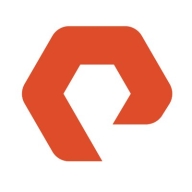


NetApp StorageGRID and Nutanix Unified Storage compete in the enterprise storage solutions category. Nutanix appears to have the upper hand due to its high availability, scalability, and comprehensive data analytics and protection features.
Features: NetApp StorageGRID offers S3 bucket capabilities for remote access, advanced deduplication and compression, and effective backup and recovery, ideal for data-dense environments. Nutanix Unified Storage provides high availability, scalability, and smooth integration with other systems, delivering extensive data analytics and protection capabilities that appeal to users looking for a unified storage approach.
Room for Improvement: NetApp StorageGRID could improve its graphical user interface, automation, and price structure, as users report configuration complexity and integration challenges. Nutanix Unified Storage could enhance user access auditing, security features, and support for multi-platform integration, which would simplify deployment and reduce support burdens.
Ease of Deployment and Customer Service: Both NetApp StorageGRID and Nutanix Unified Storage ensure reliable deployment environments. NetApp users note occasional support needs due to documentation gaps, whereas Nutanix users appreciate the flexible integration across different environments but seek more tailored customer support.
Pricing and ROI: NetApp StorageGRID is considered more expensive, offering savings over time by negating alternative data recovery costs. Nutanix Unified Storage is seen as more cost-effective, providing significant ROI through operational efficiency and simplified storage management, especially attractive to organizations already using Nutanix platforms.
It does not require much management once you set up correctly, so it saves time, allowing an admin to focus on other work.
For me, the biggest return on investment when using this solution is that we do not have to have much support staff to run it.
The scalability challenge with previous systems is lessened with Nutanix since we can expand by adding new hardware without needing migrations.
We are saving approximately 20% to 25% compared with the competition.
I would rate them an eight out of ten.
The support is done through email and is not that great, making it a very problematic area I've been dealing with for over four years.
When evaluating the technical support of NetApp StorageGRID, I would give it an eight out of ten.
I would rate the support for NetApp StorageGRID as eight out of 10.
That's due to the fact that we haven't implemented all the technical support facilities in NetApp.
They come on the call, start troubleshooting immediately, and resolve issues effectively.
They are very knowledgeable, and if they can't solve the problem, they find the answer within a day or so.
I would give the customer service and technical support a ten out of ten.
Pure Storage FlashBlade is scalable.
The scalability of NetApp StorageGRID has been proven as we've expanded twice.
The scalability of NetApp StorageGRID rates an eight or nine out of ten.
This means you don't have to buy everything upfront; you can buy what you need and add more as you grow, which is advantageous.
These three components utilize scalability tools, enabling storage addition to nodes and supporting independent, linear performance growth.
I find the scalability of Nutanix Unified Storage (NUS) to be excellent, and I would rate it a ten based on my clients' requirements.
In case there is any issue with any blade, the data is moved to another.
My impression of the stability of NetApp StorageGRID is quite high; from one to ten, I would rate it a nine.
We experienced very little stability issues.
We have not experienced these issues with Nutanix, which I attribute to the all-flash technology, the quality of their platform, and the responsiveness of the hyper-converged infrastructure.
Nutanix Unified Storage (NUS) is very stable.
It automatically triggers tasks, causing performance issues.
Technical support definitely needs significant improvement.
Its configuration should be easier.
They need to focus on a better upgrade path with easier and more resilient upgrades.
It would be great if it could fix internal issues itself without manual intervention.
In terms of functionality, reliability, and scalability, we are satisfied with NetApp.
The main concern is pricing, which could deter some customers; addressing this would enhance its appeal.
The system should move towards AI-driven optimization and enhance S3 object storage capabilities.
System downtime can disturb the entire ecosystem and impact all applications.
The pricing of Pure Storage FlashBlade is expensive compared to other products I used from other companies in the past, but one benefit is that they have built-in ransomware protection.
I'd rate the pricing eight out of ten.
It would definitely be more on the expensive side, especially if you compare it with open source solutions like Ceph.
From what I understood, it was cheaper than EMC ECS, though this was over seven years ago.
Compared to buying three or four vendor solutions, it is much cheaper.
The cost has doubled for the same amount of data, which was a challenge when presenting use case justifications for the increased cost.
Nutanix Unified Storage (NUS) has definitely helped reduce our total cost of ownership.
We can plug in many blades, and we can have data up to one terabyte.
The best features of Pure Storage FlashBlade include better throughput and better performance.
The feature of NetApp StorageGRID that has significantly improved data storage management for my customers is the value of the S3 API because it allows developers who are not infrastructure-oriented to use it and write code against it.
NetApp StorageGRID is a great alternative to AWS S3 buckets.
The scalability is very effective for our customers.
Nutanix Unified Storage (NUS) is appreciated for its fault tolerance and redundancy at the cluster level, which ensures reliable storage of files, folders, and other information accessible on the client side.
The cybersecurity features of Nutanix Unified Storage (NUS) when dealing with unstructured data, such as ransomware threats, provide the ability to detect and back up block-based storage, allowing me to restore repositories or sets of block storage with one button click, which is automatic.
My experience with using Nutanix Unified Storage (NUS) for data-intensive workloads is that we have many SQL Servers and they perform much better than they did when we used hybrid converged previously.
| Product | Market Share (%) |
|---|---|
| Nutanix Unified Storage (NUS) | 3.0% |
| Pure Storage FlashBlade | 5.7% |
| NetApp StorageGRID | 5.8% |
| Other | 85.5% |



| Company Size | Count |
|---|---|
| Small Business | 11 |
| Midsize Enterprise | 11 |
| Large Enterprise | 20 |
| Company Size | Count |
|---|---|
| Small Business | 5 |
| Midsize Enterprise | 4 |
| Large Enterprise | 11 |
| Company Size | Count |
|---|---|
| Small Business | 27 |
| Midsize Enterprise | 30 |
| Large Enterprise | 63 |
FlashBlade is the industry’s most advanced scale-out storage for unstructured data, powered by a modern, massively parallel architecture to consolidate complex data silos (like backup appliances and data lakes) and accelerate tomorrow’s discoveries and insights.
Store and manage unstructured data at scale using NetApp StorageGRID for secure, durable object storage. Place content in the right location, at the right time, and on the right storage tier, optimizing workflows and reducing overall costs for globally distributed rich media.
Nutanix Unified Storage provides high availability and seamless cloud platform integration, ensuring robust redundancy, scalability, and streamlined management. It supports hybrid cloud connectivity, enhancing storage security and performance.
Nutanix Unified Storage is designed for effective data protection across block, file, and object storage, offering features like ransomware detection and a centralized management interface through Prism Central. Users gain improved SLAs and IT cost savings through its efficient performance. Despite its user-friendly interface, there is a demand for enhanced security measures such as Multi-Factor Authentication and DLP. While its resilience is notable, users seek improvements in protocol compatibility, storage capabilities, pricing, and support processes.
What are the most important features of Nutanix Unified Storage?Industries implement Nutanix Unified Storage for tasks such as file storage, database performance improvement, and storage solution consolidation. Companies deploying virtual machines, securing against ransomware, connecting hybrid clouds, and backing up data find it useful. It supports workloads like Citrix VDI, Kubernetes, and research data, assisting many organizations migrating from legacy storage for better cost efficiency and reduced data center footprints.
We monitor all File and Object Storage reviews to prevent fraudulent reviews and keep review quality high. We do not post reviews by company employees or direct competitors. We validate each review for authenticity via cross-reference with LinkedIn, and personal follow-up with the reviewer when necessary.